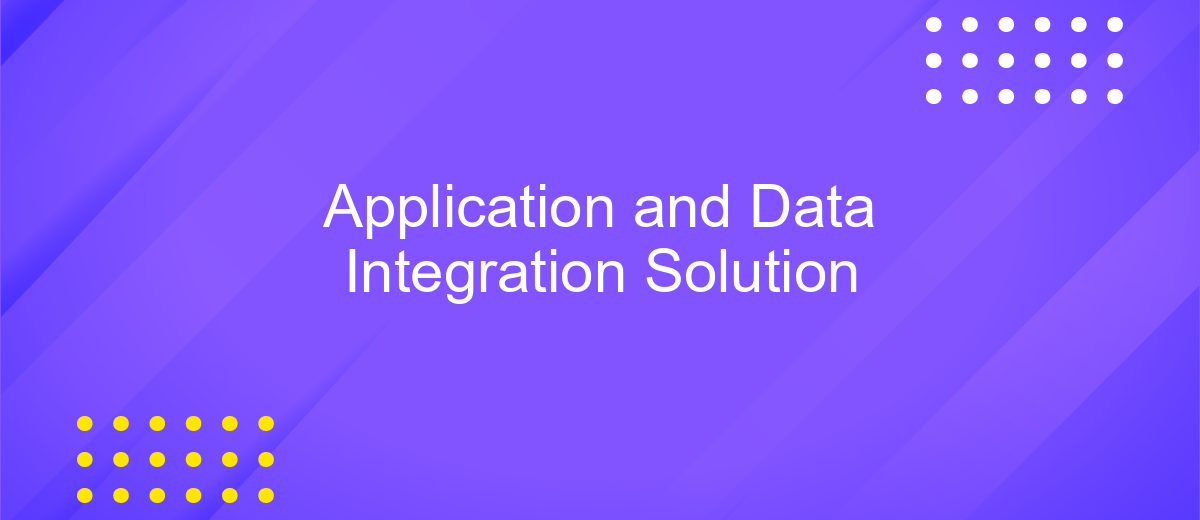Application and Data Integration Solution
In today's digital landscape, seamless integration of applications and data is crucial for business efficiency and innovation. Our Application and Data Integration Solution offers a comprehensive approach to unify disparate systems, ensuring real-time data flow and enhanced operational performance. By leveraging cutting-edge technology, we enable businesses to streamline processes, improve decision-making, and stay competitive in an ever-evolving market.
Application and Data Integration Solution
In today's rapidly evolving digital landscape, the need for robust application and data integration solutions has never been more critical. These solutions enable organizations to seamlessly connect disparate systems, ensuring data consistency, accuracy, and accessibility across various platforms. By leveraging advanced integration technologies, businesses can enhance operational efficiency, improve decision-making processes, and drive innovation.
- Streamlined workflows through automated data exchange
- Enhanced data accuracy and consistency
- Improved decision-making with real-time data access
- Increased operational efficiency and productivity
- Scalability to support growing business needs
Implementing an effective application and data integration solution involves selecting the right tools and technologies that align with organizational goals and requirements. It also requires a strategic approach to integration, incorporating best practices and leveraging expertise to ensure seamless connectivity and optimal performance. As a result, businesses can achieve a unified, agile, and responsive IT environment that supports continuous growth and innovation.
Introduction

In today's rapidly evolving digital landscape, the seamless integration of applications and data has become a critical component for businesses aiming to enhance efficiency and drive innovation. Application and data integration solutions enable organizations to connect disparate systems, ensuring that data flows smoothly across various platforms. This connectivity not only helps in streamlining operations but also provides valuable insights that can drive strategic decision-making.
One of the leading tools facilitating these integrations is ApiX-Drive, a versatile service designed to automate and simplify the integration process. By leveraging ApiX-Drive, businesses can effortlessly synchronize data between multiple applications, reducing the need for manual intervention and minimizing the risk of errors. Whether it's connecting CRM systems with marketing platforms or integrating e-commerce solutions with inventory management systems, ApiX-Drive offers a robust and user-friendly solution that empowers organizations to achieve their integration goals efficiently.
Benefits

Integrating applications and data within an organization offers numerous advantages that enhance operational efficiency and drive business growth. By leveraging a comprehensive integration solution, businesses can streamline processes, reduce costs, and improve decision-making capabilities.
- Enhanced Efficiency: Integration eliminates redundant tasks and automates workflows, leading to faster and more efficient operations.
- Improved Data Accuracy: Consolidating data from various sources ensures consistency and accuracy, reducing errors and discrepancies.
- Scalability: A robust integration solution supports business growth by easily accommodating new applications and data sources.
- Better Decision-Making: Unified data provides comprehensive insights, enabling informed and strategic decision-making.
- Cost Savings: By automating processes and reducing manual interventions, businesses can significantly cut operational costs.
In summary, adopting an application and data integration solution is a strategic move that empowers businesses to operate more effectively, respond to market changes swiftly, and maintain a competitive edge. The benefits of such integration are far-reaching, impacting various aspects of business operations and contributing to overall success.
Steps in Implementation

Implementing an application and data integration solution requires a structured approach to ensure seamless integration and minimal disruption to existing systems. The first step involves conducting a thorough analysis of the current infrastructure and identifying the specific needs and objectives of the integration project. This helps in understanding the scope and potential challenges that may arise during the implementation process.
Next, it's essential to select the right tools and technologies that align with the identified requirements. This includes choosing integration platforms, middleware solutions, and data transformation tools that can effectively handle the integration tasks. Additionally, defining clear integration workflows and data mapping strategies is crucial for ensuring data consistency and accuracy.
- Analyze current infrastructure and define objectives
- Select appropriate tools and technologies
- Define integration workflows and data mapping strategies
- Develop and test integration modules
- Deploy integration solution and monitor performance
After the development and testing of integration modules, the final step is to deploy the solution and continuously monitor its performance. Regular monitoring allows for the identification of any issues or inefficiencies, enabling timely adjustments and optimizations to maintain seamless integration and optimal performance.


Conclusion
In conclusion, the implementation of robust application and data integration solutions is essential for modern enterprises aiming to enhance operational efficiency and data consistency. By seamlessly connecting various software systems and data sources, businesses can achieve real-time data synchronization, minimize manual data entry, and reduce the risk of errors. This, in turn, leads to improved decision-making processes and better overall performance.
One notable tool that facilitates these integrations is ApiX-Drive. With its user-friendly interface and powerful automation capabilities, ApiX-Drive allows organizations to effortlessly link disparate applications and data systems. This not only simplifies the integration process but also ensures that data flows smoothly across platforms, enabling businesses to focus on their core activities without being bogged down by technical complexities. As enterprises continue to evolve, leveraging such integration solutions will be crucial in maintaining a competitive edge and driving innovation.
FAQ
What is an Application and Data Integration Solution?
Why is data integration important for businesses?
How can I automate workflows between different applications?
What types of data can be integrated?
What should I consider when choosing an integration solution?
Strive to take your business to the next level, achieve your goals faster and more efficiently? Apix-Drive is your reliable assistant for these tasks. An online service and application connector will help you automate key business processes and get rid of the routine. You and your employees will free up time for important core tasks. Try Apix-Drive features for free to see the effectiveness of the online connector for yourself.

